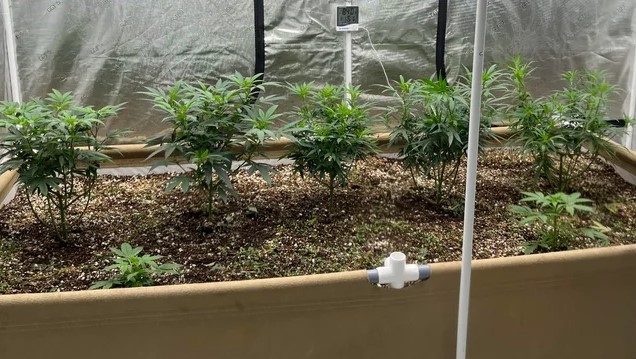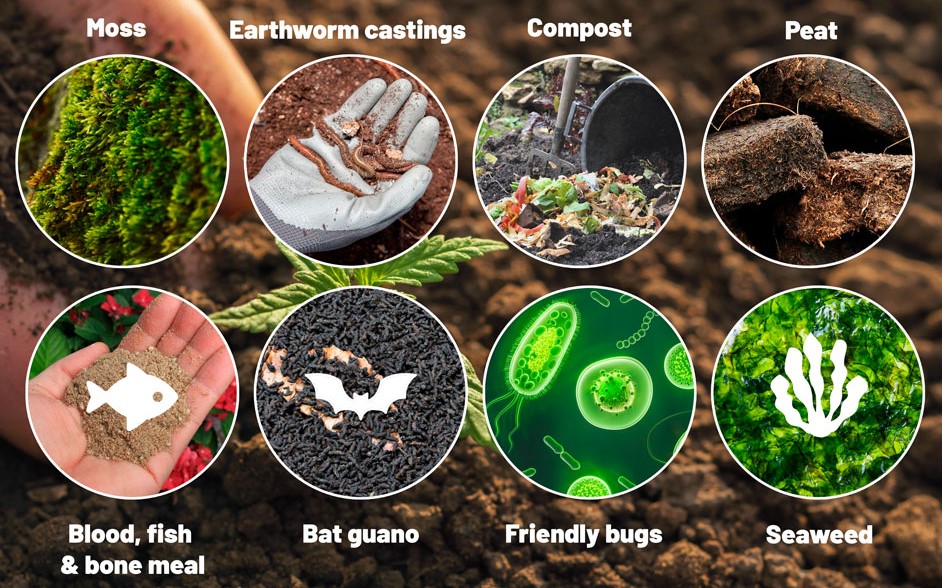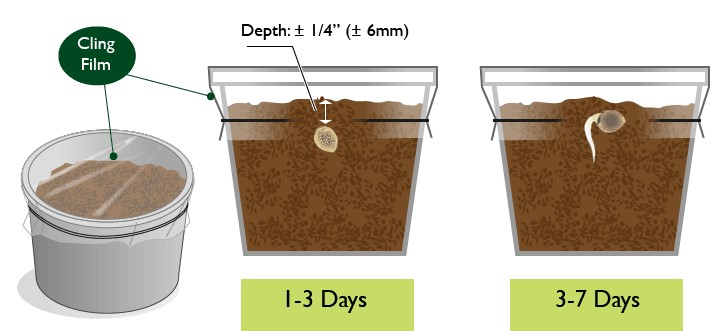Growing cannabis in living soil is gaining popularity among both experienced and novice growers. This method involves creating a healthy ecosystem within the soil, allowing beneficial microorganisms to break down organic matter and release valuable nutrients for the plants’ growth. In this comprehensive guide, we will explore the advantages and disadvantages of using living soil, the components that make up a thriving soil food web, watering requirements, the best type of growers suited for this technique, and much more. So, let’s dive in and learn how to cultivate cannabis using living soil!
Table of Contents
The Good and Bad of Living Soil for Cannabis
Soil Food Web vs. Nutrient Feeding
Recipe for Homemade Living Soil
No-Till Living Soil with Recipe
Watering Cannabis in Living Soil
Starting Cannabis Seeds in Living Soil
Frequently Asked Questions (FAQs)
What is Living Soil?
Understanding the Concept
Growing cannabis in living soil is an approach that aims to replicate the natural conditions found in nature. The idea is to create an environment where beneficial bacteria, fungi, and other microorganisms thrive, breaking down organic matter and transforming it into easily absorbable nutrients for the cannabis plants. By mimicking these processes indoors, growers can achieve highly efficient root zones that constantly recycle and create new nutrients, ensuring the health of the cannabis root system.
Mimicking Nature’s Processes
In nature, the soil is teeming with microorganisms that play a crucial role in nutrient cycling. These microorganisms, including bacteria, protozoa, arthropods, nematodes, and fungi, break down organic matter present in the soil, releasing valuable nutrients that plants can utilize for growth. By recreating this natural ecosystem in a controlled indoor environment, growers can harness the benefits of living soil and simplify their cultivation process.
The Good and Bad of Living Soil for Cannabis
Advantages of Using Living Soil
- Reusability: Living soil can be replenished and reused multiple times, making it a sustainable option for growers.
- Enhanced Flavor and Aroma: Cannabis grown in living soil often exhibits a superior taste and aroma profile compared to plants grown using synthetic nutrients.
- Self-Sustaining Nutrition: With a sufficiently large grow container of living soil, additional bottled nutrients may not be necessary, as the soil continuously creates its own nutrition.
- Organic Growing: Living soil allows for fully organic cultivation without the need for synthetic additives, reducing the environmental impact of the grow.
- Reduced Flushing: Unlike other cultivation methods, living soil rarely requires flushing, as the soil maintains a balanced nutrient profile.
Potential Drawbacks to Consider
- Higher Cost: Living soils are often more expensive than traditional grow mediums, which may deter some growers from trying this approach.
- Specialized Production: Living soils are often crafted in smaller quantities by specialist producers, limiting availability compared to mainstream grow mediums.
- Learning Curve: Using living soil requires understanding the intricacies of soil biology and may require a learning curve for less experienced growers.
Soil Food Web vs. Nutrient Feeding
How Soil Food Web Works
The soil food web refers to the intricate network of organisms and interactions within the soil ecosystem. In living soil, microorganisms such as bacteria, fungi, protozoa, nematodes, and arthropods work together to break down organic matter and release essential nutrients for plant uptake. This process provides a continuous supply of micro and macronutrients that fuel the growth of cannabis plants.
Differences from Nutrient Feeding
In contrast, nutrient feeding involves providing plants with synthetic or mineral-based nutrients directly through the water or soil. Hydroponic growers, for example, rely on precise formulations of mineral nutrients to supply the plants with essential elements necessary for photosynthesis and biomass production. The soil food web, on the other hand, relies on the breakdown of organic matter to release nutrients naturally, eliminating the need for external nutrient supplementation.
Components of Living Soil
Blending living soil is considered a skill that takes time to master, and the exact composition may vary among different suppliers. However, several common ingredients are typically found in living soil blends:
- Moss: Moss provides moisture retention and contributes to the overall structure of the soil.
- Compost: Compost adds organic matter and beneficial microorganisms to the soil.
- Peat: Peat helps with water retention and provides a stable environment for root development.
- Earthworm Castings: Earthworm castings enrich the soil with nutrients and beneficial microorganisms.
- Blood, Fish & Bone Meal: These natural sources of nitrogen, phosphorus, and potassium provide essential macronutrients.
- Bat Guano: Bat guano is a potent source of nutrients, including nitrogen and phosphorus.
- Friendly Bugs: Beneficial microorganisms such as fungi, bacteria, protozoa, nematodes, and arthropods create a balanced soil ecosystem.
- Seaweed & Extracts: Seaweed and kelp provide trace minerals and growth-promoting hormones for the plants.
- Additional Ingredients: Some manufacturers add rock dust, dolomite lime, or other materials to enhance the nutrient content of the soil.
The ratios of these ingredients may vary, and some suppliers may include unique components tailored to their specific blends. It is essential to ensure the living soil is in good condition and adequately moist when purchased to maintain its effectiveness.
Recipe for Homemade Living Soil
Recipe Ingredient Chart
| Ingredient | 50-Liter Batch | 100-Liter Batch | 200-Liter Batch |
|---|---|---|---|
| Base Soil | 1 bag (50 liters) | 2 bags (100 liters) | 4 bags (200 liters) |
| Coco Coir or Peat Moss | 12.5 liters | 25 liters | 50 liters |
| Perlite or Vermiculite | 6.25 liters | 12.5 liters | 25 liters |
| Well-Aged Compost | 3.125 liters | 6.25 liters | 12.5 liters |
| Worm Castings | 3.125 liters | 6.25 liters | 12.5 liters |
| Bat Guano or Seabird Guano | 3.125 liters | 6.25 liters | 12.5 liters |
| Fish Meal | 3.125 liters | 6.25 liters | 12.5 liters |
| Kelp Meal | 6.25 liters | 12.5 liters | 25 liters |
| Bone Meal | 6.25 liters | 12.5 liters | 25 liters |
| Azomite or Rock Dust | 1-2 liters | 2-4 liters | 4-8 liters |
| Mycorrhizal Fungi | 1-2 cups | 2-4 cups | 4-8 cups |
| Beneficial Bacteria | Per product instructions | Per product instructions | Per product instructions |
Instructions:
- Mixing:
- Open the bag of organic potting soil and transfer it to a large container or Tarp spread out on the ground.
- Add each amendment according to the specified volume and mix thoroughly until you achieve a uniform consistency.
- Minerals:
- Mix in the recommended amount of Azomite or glacial rock dust. This provides essential trace minerals.
- Microbial Inoculants:
- Add mycorrhizal fungi to the mix. Mycorrhizae form a beneficial relationship with plant roots, aiding in nutrient uptake.
- Include a beneficial bacteria supplement according to the product instructions. This helps establish a thriving microbial community in the soil.
- Moistening:
- Moisten the soil mix with water until it reaches a good, crumbly texture. Be careful not to over-saturate.
- Curing:
- Allow the soil mix to “cook” or cure for a few weeks before using it for your cannabis plants. This allows the microbial life to establish, and the nutrients become more bioavailable.
Now, this recipe is tailored for amending 50-liter bags of organic potting soil. Adjustments can still be made based on the specific needs of your cannabis plants and your preferences. Remember to moni
No-Till Living Soil with Recipe
Exploring the No-Till Approach
No-till living soil is a favored method among outdoor and greenhouse growers who prefer not to disturb the soil between grows. Instead of tilling or digging, growers plant cover crops after harvesting cannabis, which serve as natural organic compost. These cover crops, such as cowpea, vetch, rye grass, and buckwheat, prevent erosion, suppress weeds, and enrich the soil fertility once they decompose. No-till living soil aims to minimize environmental impact and avoids certain additives, such as bat guano or compost, due to concerns about their sourcing or potential chemical residues.
No Till Living Soil Recipe Chart
| Ingredient | 50-Liter Batch | 100-Liter Batch | 200-Liter Batch |
|---|---|---|---|
| Base Soil | 4 parts (12.5 liters) | 8 parts (25 liters) | 16 parts (50 liters) |
| Coco Coir or Peat Moss | 1 part (3.125 liters) | 2 parts (6.25 liters) | 4 parts (12.5 liters) |
| Perlite or Vermiculite | 1 part (3.125 liters) | 2 parts (6.25 liters) | 4 parts (12.5 liters) |
| Well-Aged Compost | 1 part (3.125 liters) | 2 parts (6.25 liters) | 4 parts (12.5 liters) |
| Worm Castings | 1 part (3.125 liters) | 2 parts (6.25 liters) | 4 parts (12.5 liters) |
| Kelp Meal | 1 part (3.125 liters) | 2 parts (6.25 liters) | 4 parts (12.5 liters) |
| Alfalfa Meal | 1 part (3.125 liters) | 2 parts (6.25 liters) | 4 parts (12.5 liters) |
| Rock Dust | 1-2 cups | 1-2 cups | 2-4 cups |
| Mycorrhizal Fungi | 1-2 cups | 1-2 cups | 2-4 cups |
| pH Adjustment (if needed) | Per product instructions | Per product instructions | Per product instructions |
Instructions:
- Mixing:
- Combine all the ingredients in a large container or directly in your growing bed.
- Thoroughly mix the components to ensure an even distribution.
- Adjust pH:
- Test the pH of the mix and adjust if necessary using dolomite lime.
- Moistening:
- Moisten the soil mix with water until it reaches a good, crumbly texture. Avoid over-saturation.
- Curing:
- Allow the soil mix to “cook” or cure for a few weeks before planting. This helps establish a beneficial microbial community.
- Planting:
- Once the soil is adequately cured, you can plant your cannabis directly into the no-till living soil.
Benefits and Composition of No-Till Soil
No-till living soil is typically composed of a blend of specialist slow-release ingredients, ensuring long-lasting soil fertility. Common components include wood, biochar, peat, rice husks, perlite, crab or crustacean shells, kelp, diatomaceous earth, blended mineral dust, and fish products. By relying on natural processes and a rich soil ecosystem, no-till living soil proponents claim that it produces the best flavors and terpene profiles in cannabis.
Watering Cannabis in Living Soil
Regular watering is crucial when growing cannabis in living soil to prevent the soil from drying out and losing the benefits of the microorganisms present. In addition to fulfilling the water needs of the plants, watering also helps maintain the activity of the beneficial bacteria, fungi, and other microorganisms in the soil. While living soil can provide a self-sustaining root ecosystem, some growers may occasionally prepare nutrient teas to replenish and recharge the soil, particularly during the flowering stage.
Best Growers for Living Soil
Living soil is suitable for a range of growers, but it may be more beneficial for certain types of individuals:
- Less Experienced Growers: Novice growers may benefit from starting with traditional grow mediums before transitioning to living soil. Once basic growing skills are acquired, living soil can offer a more rewarding and forgiving cultivation experience.
- Organic Growers: Those committed to organic cultivation methods often gravitate towards living soil due to its ability to provide a self-sustaining root ecosystem without the need for synthetic additives. Living soil aligns with the principles of permaculture, where waste is recycled to create more produce, making it an attractive option for environmentally conscious growers.
Starting Cannabis Seeds in Living Soil
Starting cannabis seeds directly in living soil is a common practice among growers who prefer this cultivation method. While many manufacturers recommend germinating seeds in living soil, it is advisable to check with the supplier for specific guidelines. The living soil provides a conducive environment for seed germination and allows for a seamless transition from seedling to mature plant, ensuring continuous nutrient availability throughout the entire growth cycle.
Is Living Soil Worth It?
Living soil offers numerous benefits, but it also comes with a higher cost compared to traditional grow mediums. However, many growers who have embraced living soil report vibrant and vigorous plant growth, along with simplified cultivation processes. By maintaining a nutrient sweet spot without the risk of over or underfeeding, living soil allows growers a wider range of latitude and minimizes the chances of stunting growth or compromising final yield and quality. While not every grower may choose to use living soil, those who do often appreciate the positive results it delivers.
Frequently Asked Questions (FAQs)
- Can living soil be used for indoor and outdoor cannabis cultivation?
- Yes, living soil is suitable for both indoor and outdoor cannabis cultivation. It provides a natural and sustainable environment for plant growth.
- How often should I water my cannabis plants in living soil?
- The frequency of watering depends on various factors, including environmental conditions and plant development. Monitor soil moisture and adjust watering accordingly.
- Is living soil suitable for all cannabis strains?
- Yes, living soil is compatible with various cannabis strains, including autoflowering, feminized, and regular seeds. Adjustments may be needed based on specific strain preferences.
- Can I use living soil with hydroponic or aquaponic systems?
- Living soil is designed for traditional soil-based cultivation. It may not be suitable for hydroponic or aquaponic systems, which have different nutrient delivery methods.
- Do I need to supplement nutrients when using living soil?
- In a well-established living soil system, additional nutrient supplementation may not be necessary. However, some growers choose to use nutrient teas during specific growth stages.
- How do I maintain pH in living soil?
- Living soil typically regulates pH naturally, but if adjustments are needed, consider using dolomite lime. Monitor pH regularly and make adjustments as necessary.
- Can living soil be reused for multiple cannabis grows?
- Yes, living soil can be replenished and reused for several grows, making it a sustainable and cost-effective option for cannabis cultivation.
Conclusion
Growing cannabis in living soil offers an alternative approach that mimics nature’s processes and provides a self-sustaining root ecosystem. While it may require a larger initial investment and a learning curve for some growers, the benefits of living soil, such as enhanced flavor and aroma, reduced reliance on synthetic additives, and the potential for reusability, make it an appealing choice for many. Whether you choose to purchase premade living soil or create your own blend, this cultivation method offers a rewarding experience with the potential for vibrant and vigorous cannabis growth. Consider exploring living soil for your future grows and witness the magic of a thriving soil food web in action.





